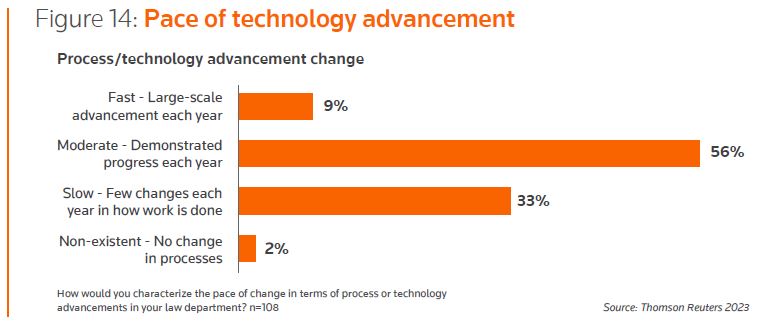Jump to:
| How legal technology helps improve operations |
| Challenges to legal tech adoption |
| Solving the legal technology conundrum |
Corporate law departments are in a conundrum when it comes to legal technology adoption. You see, while 72% of in-house legal department operations professionals see using technology to simplify workflow as a high priority, a mere 32% report an increase in their legal technology budget.
What’s more, fully 90% say their department makes only slow to moderate progress in adopting new technology, according to the 2023 Legal Department Operations Index from Thomson Reuters. The report also found that 78% of legal department operations professionals see cost control as a high priority.

Figure 1: The Technology Conundrum: Despite the desire to leverage new technology to enhance efficiency and effectiveness, slow progress and flat budgets remain significant barriers.
The Technology Conundrum is this: how do legal departments take advantage of the transformational power of modern legal tech without additional budget to do it? And how do they overcome slowness to adopt despite the huge gains in efficiency and effectiveness the whole team can make?
How legal technology helps improve operations
Despite the slowness to adopt, 53% of law departments reported that they increased their use of legal technology in the past year, mostly without increasing the share of their budget dedicated to legal tech. Instead, they may have seen faster adoption of the tools they already have. Their increased use of technology helped them increase their productivity and their attorneys’ output despite flat to declining budgets.
Better technology tools help with efficiency and effectiveness in many ways. Here are two ways that align with the priorities of legal departments Thomson Reuters surveyed:
Controlling outside legal spend: The worked rate increases that law firms are requesting are “approaching historic highs,” according to the Legal Department Operations report. Still, clients are finding ways to mitigate the impact of these increases. One big strategy is shifting work from the Am Law 100 to midsize firms. This allows the client to realize a net cost savings. Legal departments that use a modern spend management system have visibility into rates across firms and regions to make this determination.
Simplifying work through technology: Legal departments clearly recognize the value of e-billing and matter and spend management tools, with nearly 93% making some sort of investment in these tools. A modern matter management solution can save a legal department significant money over time. In fact, a Forrester Total Economic Impact report on Thomson Reuters Legal Tracker found that the system paid for itself in six months, largely due to savings in outside counsel rate increases.
Challenges to legal tech adoption
According to the Thomson Reuters report, law departments are making some progress with their technology adoption, but very few are making large scale advances each year. (See figure 2.) The report points to “inertial forces” to explain the pace.
For instance, legal department leaders are very good at their legal work – and they are more comfortable sticking with what they know rather than risking breaking their system. And the large organizations these leaders support are often slow to change the way they work. Given how closely the law department works with other areas of the business, making large-scale change to law department systems can be a cross-functional challenge.

Figure 2 Most law departments are making modest advances in their technology adoption each year.
Solving the legal technology conundrum
It is very clear from the report that legal operations professionals know how much technology can help their departments manage spending while delivering effective, efficient service. Many of them are finding support in the metrics they track. These are metrics that can help influence law department leaders when it comes to allocating the existing budget or even asking for additional resources.
The report notes that it is common for law departments to track metrics related to cost efficiency. The opportunity for legal operations professionals is to add in metrics related to the law department’s effectiveness, how it enables the business, and how it provides protection. Some metrics to consider include rate of staff turnover, volume of work automated, uptake of existing tech stack, percentage of matters with desired outcomes, and department net promoter score by internal clients.
With this data in hand, you can make a compelling case for technology that both saves money and improves effectiveness. Remember, you have three levels of stakeholders to convince: the executives who approve the legal department budget, the leaders of your department, and the individual users. By framing your argument in both efficiency and effectiveness, you’ll be able to motivate these three groups much more quickly.
Solving the Technology Conundrum won’t be fast or simple – but it is possible. The 2023 Legal Department Operations Index can help you put the conundrum in perspective for your legal department. It provides insights and industry practices that can help your department make data-driven decisions and improve your strategic planning and technology adoption.
_________________________________________________________________
Download your copy of the 2023 Legal Department Operations Index for more insights on how your colleagues are approaching the Technology Conundrum.










